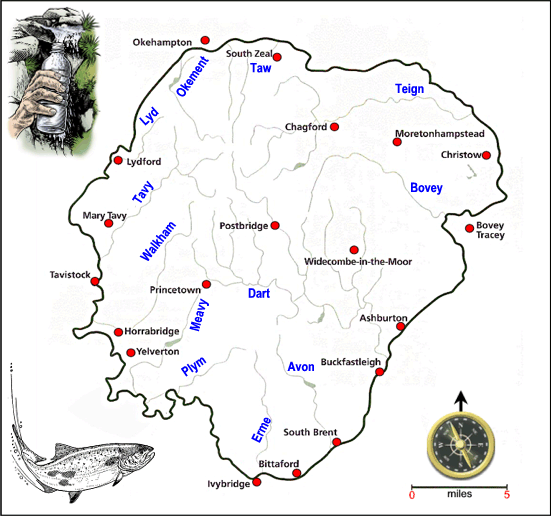
Water is one commodity Dartmoor is not short of although experts would say that the moor is getting dryer. Having had the luxury of living in a house that got its own water supply direct from a Dartmoor spring I can say it is the coldest, sweetest water you can taste.
Dartmoor is the source of most of Devon’s rivers, which begin their journeys in the bogs and mires of the high moor. The main rivers are the Teign, Dart, Avon, Erme, Yealm, Plym, Tavy, Okement and Taw. They are acidic, steep and fast flowing, with a speedy response to rainfall and are classified as torrent rivers.

The Main Rivers of Dartmoor.
If you take the 25 rivers on Dartmoor their approximate total length of the moorland courses is 137 miles and the total combined length from source to sea is around 287 miles, this does not include streams and leats, clearly a lot of water. The earliest recorded river is the Teign and this was documented in AD739 as the Teng.
Over the centuries the moorland water has been used for many purposes such as drinking and household use, a power source for industry, hydro electricity, and leisure activities such as fishing and swimming. The earliest domestic scheme to exploit moorland water was the construction of Drake’s Leat (completed in 1591). This took water from the river Meavy and delivered it 17 miles via a leat to Plymouth. In 1793 another leat was built to carry water to Devonport, this took water from the headwaters of the West Dart, the Cowsic and the Blackabrook and carried it 21 miles to Devonport. Many of the Dartmoor towns and villages had their wells and springs which obtained the water from the moor, several still survive today. One such example is the ‘Saxon Well‘ at Widecombe on the Moor.
By the end of the 19th century these methods of supplying water to Plymouth were regarded as inadequate as open leats were prone to becoming clogged with snow in harsh winters so it was decided to build a reservoir. In 1898 Burrator reservoir was completed at a cost of £150,000 and it flooded an area of 117 acres. In 1929 the reservoir was extended to take in an area of 150 acres. This meant many moorland farms were abandoned and submerged under its waters. In 1907 the Venford reservoir was completed, this supplied water to Paignton and covered 33 acres. In 1942 Fernworthy reservoir was completed, this one covered 76 acres and supplied Torquay with water. In 1950 work began on the 110 acre, Avon reservoir, this was to supply water the South Devon Water Company. Three other reservoirs that originally were not in the bounds of the nation park are Trenchford, Kenniford and Tottiford.

Grimstone & Sortridge Leat.
As previously mentioned, there were many miles of leats built on the moor. Some delivered water to the big cities, some delivered water to towns, some delivered water-power to the tin mines and other industrial concerns and some simply delivered water to moorland farms and dwellings (pot water leats). They are a true feat of engineering because in order to work they must gently flow downhill but to look at some of them they appear to be flowing uphill. It was the engineering skills of the old tin miners that gave rise to the leat building phenomena. Many of the leats are now dry but their courses are still clearly visible as they wind around the hillside contours. The farm leats were used to provide all the water needed on the farm. This would not only be for domestic use but for watering the animals, cleaning the parlour and in many cases before refrigeration for cooling cream and cheese. A granite trough would be placed near the house and a constant flow of cold water would keep anything placed in it cold. If ever you want a gentle walk on Dartmoor simply follow a leat, this will give you a gradual ascent or descent and in some cases can be a pleasant experience. There are several features associated with leats, one being the ‘sheep leap’. This is simply two projecting slabs of granite site opposite each other on the banks of the leat. There were designed to make it easier for sheep to jump across from side to side. Another feature to be found is the ‘Bull’s Eye’. This is simply a slab of granite with a hole drilled through it. It is set into the bank of a leat and releases water into a branch channel when required. The flow can be controlled by stopping up the hole. There is a good example near the Windy Post Cross at grid reference SX 53460 74313.

‘Bull’s Eye’ Stone,
For the past 200 years one use of Dartmoor Water has been in the distillation process of the famous Plymouth Gin. The natural clarity and softness of the water makes Plymouth Gin one of the finest mixing gins available and what many say is the smoothest gin in the world.
It is surprising that with today’s fashion for bottled water and the clarity and sweetness of natural Dartmoor water there are so few moorland water products available.
Cocktail Recipe.
Blackberry and Bottle.
Glass: tumbler
Contents:
2 parts Plymouth Gin
1 part lemon juice
Splash of sugar syrup
½ part Crème de Mure (Blackberry Liqueur)
Method: Build over crushed ice. Drizzle with Crème de Mure.
Garnish: Lemon slice and blackberries
 Legendary Dartmoor The many aspects past and present of Dartmoor
Legendary Dartmoor The many aspects past and present of Dartmoor
